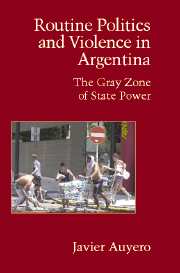Book contents
2 - Party Politics and Everyday Life
Published online by Cambridge University Press: 05 June 2012
Summary
During the 1990s, the Peronist Party shifted its urban organization from union to clientelist networks (Levitsky and Murillo 2006; Levitsky 2003). The mutually reinforcing processes of state-retrenchment, hyperunemployment, and mass-immiseration (Auyero 2000) substantially increased the influence of local brokers and party bosses who provide access to scarce state resources. As Brusco, Nazareno, and Stokes (2004:67) assert, “the recent shift to pro-market policies and the downsizing of the state seem not to have eliminated political clientelism, contrary to some expectations…. Neoliberalism may have revived clientelism.” Patronage politics is hardly new in Argentina (Rock 2005), but its social, political, and cultural relevance has escalated since the early 1990s – coincidentally, at the time when radical neoliberal reforms were undertaken by the Menem administration. During the 1990s and 2000s, as O'Donnell's (1993) “brown areas” increase their relevance in Argentina's social and political landscape, we witness the consolidation of this political practice.
Manolo and the Seventy-Five Buses
Manuel Quindimil has been the mayor of Lanús, a municipality located in Greater Buenos Aires, for the last twenty years. He is, according to the slogan of the last electoral campaign, “the last caudillo” (this slogan has been reiterated during, at least to my knowledge, the last decade). During the last presidential elections (2003), Manolo sent seventy-five buses loaded with his followers to the main rally organized by the current president Néstor Kirchner in the River Plate soccer stadium.
- Type
- Chapter
- Information
- Routine Politics and Violence in ArgentinaThe Gray Zone of State Power, pp. 55 - 72Publisher: Cambridge University PressPrint publication year: 2007

